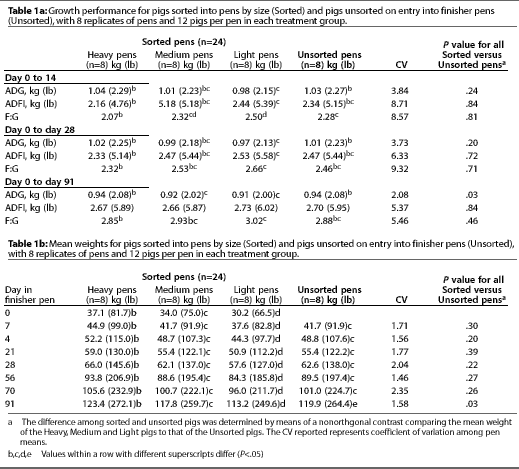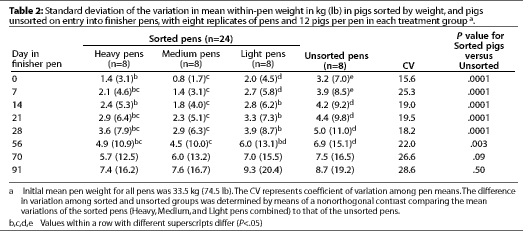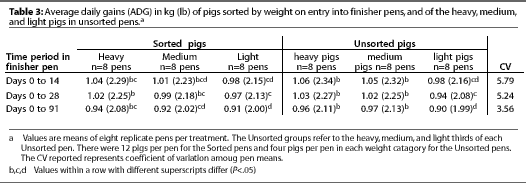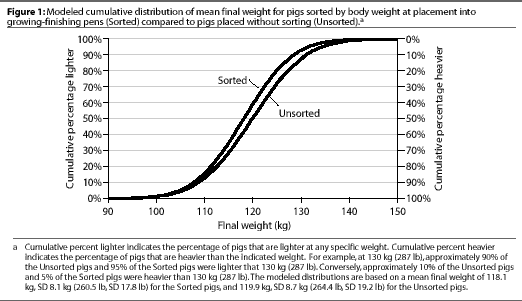Original research
Sorting growing-finishing pigs by weight fails to improve growth performance or weight variation
Patrick R. O'Quinn, MS, PhD; Steve S. Dritz, DVM, PhD; Robert D. Goodband, MS, PhD; Mike D. Tokach, MS, PhD; Janice C. Swanson, MS, PhD; Jim L. Nelssen, MS, PhD; and Robert E. Musser, MS
O'Quinn PR, Dritz SS, Goodband RD, et al. Sorting growing-finishing pigs by weight fails to improve growth performance or weight variation. J Swine Health Prod. 2001;9(1):11-16. Also available in PDF format (136k)
From the Department of Animal Sciences and Industry (O'Quinn, Goodband, Tokach, Swanson, Nelssen, and Musser) and Food Animal Health and Management Center, College of Veterinary Medicine (Dritz), Kansas State University Phone: (785) 532-4202, Fax: (603) 676-5543, e-mail: Dritz@vet.ksu.edu Contribution No. 00-387-J from the Kansas Agricultural Experiment Station, Kansas State University, Manhattan 66506. Address correspondence to Dr. Dritz.
Summary
Objective: To examine the effects on growth performance when growing-finishing pigs are sorted uniformly by weight at placement.
Methods: Pigs selected from a group of 384 were sorted into Heavy (37.1 +/- 1.4 kg), Medium (34.0 +/- 0.77 kg), and Light (30.2 +/- 2.0 kg) groups, or placed in an Unsorted group (33.8 +/- 3.2 kg) with a mean starting weight similar to that of the Medium pigs, but with quadruple the variation. Pigs and feeders were weighed on days 0, 7, 14, 21, 28, 56, 70, and 91 for determination of ADG, ADFI, feed efficiency, and within-pen pig weight variation.
Results: From day 0 to 91, ADG of Unsorted pigs and Heavy pigs did not differ, but was greater (P<.05) than that of Medium or Light pigs. Grouping had no effect on overall ADFI. Feed efficiency did not differ (P=.25) for Heavy, Medium, and Unsorted pigs, but Light pigs were less efficient (P<.05) than Heavy pigs. Final body weights differed for each group (P<.05) and ranked in the following descending order: Heavy, Unsorted, Medium, and Light. Mean final weights of Unsorted pigs were greater (P<.05) than mean final weights of all sorted pigs. No differences in within-pen SD were detectable (P=.13) by the end of the study.
Implications: Sorting pigs into finishing pens by weight has no effect on final variability in individual body weights. Placing pigs without sorting by weight may increase the amount of pork produced from a system and reduce turnaround time in barns.
Keywords : swine, sorting,
growth performance, weight variation
: swine, sorting,
growth performance, weight variation
Received: April 19, 2000
Accepted: June 28, 2000
The sorting and grouping of pigs by body weight is a common management technique believed to minimize variation in final pig body weights, and therefore to more efficiently achieve packer weight specifications. Thus, pigs commonly are regrouped at several stages during the production cycle (i.e., at weaning, placement into the grower and (or) finisher unit, and possibly again after an initial marketing of pigs from a barn). Reductions in weight gain as a result of regrouping pigs either have been undetected;1 evident only within the first week or two after regrouping;2,3 or apparent only when coupled with other stressors such as limit feeding, increased stocking density, or high ambient temperatures.4,5,6 However, Stookey and Gonyou7 proposed that pigs should not be regrouped after marketing heavier pen mates because of the associated physical and social stresses.
Results of other studies have been inconsistent when pigs were sorted into uniform groups by body weight. An early study from Great Britain8 utilized groups of pigs that initially were of identical average weight but with high or low variation in weights. The uniformity in body weights was lost by the end of the study. Similarly, Gonyou9 concluded that sorting pigs by weight was not necessary, because productivity was not affected negatively by within-pen weight variability. However, a report from the Netherlands10 indicated that growth performance was better when initial within-pen weights were uniform than when weight variability was high. In a literature summary, Gonyou concluded that it was not possible to determine what effect variation in weight might have within a particular group of finishing pigs.9
Our study was undertaken to investigate the effects of initial within-pen pig weight variation on growth performance and weight variation at marketing.
Materials and methods
In 1998, we conducted two sequential trials, each lasting 91 days. In each trial, we allotted 192 crossbred (PIC L326 or 327 boars x C22 sows) barrows and gilts, approximately 14 weeks of age and 34 kg (75 lb), to one of four treatment groups, Heavy, Medium, Light, or Unsorted. Mean weights at the beginning of the trial were:
- Heavy, 37.1 +/- 1.4 kg (81.7 +/- 3.1 lb);
- Medium, 34.0 +/- 0.77 kg (75.0 +/- 1.7 lb);
- Light, 30.2 +/- 2.0 kg (66.5 +/- 4.5 lb);
- Unsorted (medium weight, high variation), 33.8 +/- 3.2 kg (74.6 +/- 7.0 lb)
The Unsorted and Medium groups had similar mean weights at the beginning of the trial, but the initial variation in weight in the Unsorted group was quadruple that of the Medium group.
Approximately 250 pigs were available for selection for each trial. Pigs with weights more than two standard deviations from the group mean (about 12 pigs) were removed from consideration; thus, extremely heavy or extremely light pigs were not used. The remaining pigs not required for the study were selected across the weight groups so as not to disrupt the normal weight distribution. In each trial, pigs originated from a single farrowing group that farrowed over a 7-day period. Gender and ancestry were balanced within and across blocks of pens.
Before allocating them to treatment groups, barrows and gilts were sorted separately according to body weight and divided into three weight groups (Heavy, Medium, and Light). A treatment block consisted of four pens, one for each of the three weight categories and an Unsorted pen. Sorted pens were initially filled with eight barrows and eight gilts. To make up the Unsorted pens, two pigs of each gender were selected from the Heavy, Medium and Light pens so that the mean weight of the two selected pigs was the same as that of the six pigs of the same sex remaining in the pen.
Pigs were housed in a modified open-front finishing barn with 1.8m x 4.9m (6ft x 16ft), partially-slatted pens (50% slatted and 50% solid). Each pen containeda single nipple waterer and a two-hole self-feeder to allow pigs ad libitum access to water and feed.
Pigs were housed 12 per pen, providing 0.74m2 (8 ft2) per pig. Each trial consisted of four blocks of four contiguous pens, with each pen in a block housing a different treatment group. This resulted in eight replicate pens (and eight sets of observations) per treatment group for the two experimental trials.
Pigs were fed nutritionally adequate11 grain sorghum-soybean meal-based diets in three phases, with decreasing nutrient density as pig weight increased. Pigs and feeders were weighed at the beginning of each trial and again on days 7, 14, 21, 28, 56, 70, and 91, so that ADG, ADFI, and feed:gain (F:G) could be determined for each pen. Within-pen variation (SD) in individual body weights also was determined at each of the above time intervals. No behavioral data were collected in this study.
Data are reported as least square means and were analyzed as a randomized complete block with pen as the experimental unit, using the GLM procedure of SAS.12 Means were separated using the Least Significant Difference (LSD) procedure of SAS. A preplanned nonorthogonal contrast was used to compare the mean weight of the pens of Sorted pigs (Heavy, Medium and Light pens combined) to that of the Unsorted pens of pigs.
A second statistical model was used to compare the ADG of the heavy, medium, and light thirds of the Unsorted pens of pigs to their respective sorted counterpart pens. Therefore, the experimental unit for the Unsorted pigs was four pigs per pen, representing one of the three sorted weight categories, and resulting in three experimental units per pen. The experimental unit for the sorted groups was 12 pigs per pen, representing a weight category. The ADG of these six groups (Light, Medium, Heavy, and Unsorted light, medium, and heavy) were also compared statistically by the LSD procedure. All probability values were considered significant at P<.05. Finally, the cumulative distribution of pig weight was modeled to compare the mean final weight of the Sorted pigs (three weight groups combined) to the Unsorted pigs. The distribution was obtained from mean final weight and within-pen SD using the normdist function in Microsoft Excel(TM).
Results
The ADG and ADFI for the Heavy and Medium pigs and Unsorted
pigs did not differ (P>.15) from day 0 to 14 or from
day 0 to 28 (Table 1a). However, both Heavy and Unsorted pigs
grew faster (P<.05) than Light pigs, with Medium pigs
being intermediate during these same time intervals. Growth performance
did not differ (P>.20) between the Sorted pigs and Unsorted
pigs during these two periods. For the overall growth period (day
0 to 91), ADG for the Heavy and Unsorted pigs did not differ (P=.82),
and ADG for the Medium and Light pigs did not differ (P=.42),
but ADG was greater for the Heavy and Unsorted pigs (P<.05)
than for the Medium and Light pigs. In addition, the ADG for the
Unsorted pigs was greater (P=.03) than the mean ADG for
the sorted pigs. No differences (P=.35) were observed for
ADFI during the overall growth period (day 0 to day 91). However,
while F:G did not differ (P=.25) among Heavy, Medium, and
Unsorted pigs, it was lowest for Light pigs, and intermediate
for Medium pigs.

As expected, mean pig weights on day 0 were highest (P<.05) for Heavy pigs, lowest for Light pigs, and intermediate and similar for Medium and Unsorted pigs (Table 1b). This trend continued through day 70. However, at the termination of the study (day 91), Heavy pigs were heaviest, followed by Unsorted, Medium, and Light pigs. The mean final weight of the Unsorted pigs was greater (P=.03) than that of the Sorted pigs (three weight groups combined).
Initial weight variation was smallest (P<.05) for
Medium pigs (Table 2) and was 25% of the initial weight variation
for the Unsorted group, even though the mean weights were similar.
Additionally, the mean weight variations of the four treatment
groups differed (P<.05), indicating that the population
from which the pigs had been selected was slightly skewed to the
lighter pigs. If the population had been perfectly normal, identical
within-pen variation would be expected for the Light and Heavy
pigs. Nevertheless, initial mean weight variation of the Light
and Heavy pigs was less than that of the Unsorted group and more
than that of the Medium group. As time on test progressed, differences
in mean weight variation among the three sorted groups diminished.
By day 70, mean within-pen SD for the Heavy, Medium, Light, and
Unsorted pens did not differ (P>.05), and the difference
in weight variation of the Unsorted pigs compared to that of the
Sorted pigs had diminished to a nonsignificant level (P=.50).
It should be noted that the within-pen variation was less at the
end of the test than commonly observed,13,14 but was
similar to that reported in another study.15 Assuming
an 80% power, we estimate that approximately a 30% difference
was needed to detect a statistically different response for within-pen
SD in our experiment.16

An examination of the ADG in matched groupings of pigs (Table
3) revealed that pigs sorted by body weight failed to have consistently
better growth performance than the Unsorted pigs. From day 0 to
91, Heavy pigs, and the heavy and medium thirds of the Unsorted
pens, had the highest ADG's (P<.05). The Medium pigs
were intermediate, and the Light pigs and light third of the Unsorted
pens had the lowest ADG's. Modeling the cumulative distribution
of the final weights of the Sorted and Unsorted groups indicated
that the distribution was shifted to the right for the Unsorted
pigs, toward an increased number of heavier pigs (Figure 1).


Discussion
Minimizing weight variation is a priority goal of swine producers. Wide variations in body weights are viewed negatively for many reasons,9 including the following: 1) high variations in within-pen weights result in less efficient use of dietary nutrients; 2) marketing programs typically require, and reward for, uniform weight pigs; and 3) barn productivity is dependent upon emptying rate, which generally depends upon the performance of the smallest pigs. For these reasons, pigs routinely are sorted and housed in uniform groups based on body weight.
Most available data on growing-finishing pigs pertains to the effects of regrouping,4,7 space allowances,6,17 or intervention strategies to reduce agonistic behavior.3,18 To our knowledge, only a few published papers8,9,10 have reported the effects of initial grouping on pen body weight variation. The results of our study agree with earlier work8,9 suggesting that pigs grow to common end-point variability, thus reducing the need for initially sorting by body weight. Our study illustrates the point that a certain degree of weight variation may be necessary within a social group. One study to the contrary10 concluded that fattening pigs ideally should be grouped by small differences in weight between pigs within a pen.
Gonyou9 concluded that overall productivity is not affected negatively by within-pen weight variability. Our data support this conclusion. In fact, our data suggest that productivity may actually be enhanced, since the pig weight cumulative distribution was shifted toward an increased number of heavier pigs as a result of the ADG of the Unsorted pigs being greater than the mean ADG of the sorted groups. While we did not observe a difference in within-pen weight variation at the conclusion of our study, it should be noted that within-pen weight variations for the Light and Medium groups were numerically lower than for the other groups, but did not attain the approximately 30% treatment variation needed to detect a significant difference. Nonetheless, it is apparent that the large differences in within-pen variation observed at the beginning of the study were not maintained until the end of the study.
The ADG (day 0 to 91) was highest for Heavy and Unsorted pigs and lowest for Medium and Light pigs. Sorting into uniform groups by body weight did not affect feed intake, and F:G generally followed the same patterns as ADG. An earlier study19 indicated that small pigs grew better when they were part of a pen that contained large and medium pigs than when penned with similarly small pigs. However, medium pigs grew better when penned by body weight. Our data indicate that light pigs housed in pens containing medium and heavy pigs do not grow any differently than uniformly penned light pigs. However, medium pigs in unsorted pens did grow substantially faster than medium pigs penned uniformly by body weight. This is further illustrated by the increasing differences in the cumulative distributions from 110 to 125 kg (242 to 276 lb). The reason is not readily apparent. Other research has indicated that there is less fighting in groups of weaned pigs with large weight variation.20,21 The subordinatepigs are less likely to fight for dominance if their weight difference is large. Potentially, the social hierarchy in a pen containing heavy, medium, and light pigs is initiated instantly, whereas it may take several weeks to develop in a pen of uniformly medium pigs. However, additional research is needed to confirm this hypothesis.
We believe a practical interpretation of our results can be applied to all in, all out management. The use of all in, all out implies that management is at the group level. Thus, if nursery groups are similar in size to finisher groups, we believe pens stocked with pigs that have a wide variation in weight will show better group growth performance than those sorted by initial body weight. Additionally, if some pigs are marketed before the group is closed out, mixing and resorting of pigs can be minimized, since the heaviest pigs can be removed from each pen.
However, if the nursery group is larger than the finisher group, the pigs should be sorted into finisher groups by weight. For example, if a nursery contains 2000 pigs and is used to stock two 1000-head finisher groups, the pigs should be sorted and categorized into heavy and light groups. We base this on our finding that the Light group was still lighter than the Heavy group at the end of our trial. Thus, the heavier barn or groups could be closed out sooner and restocked faster, resulting in better facility utilization for the heavy category. However, we advocate leaving the pigs within each initial weight category unsorted, as this provides maximal weight variation within each pen, capturing as much as possible of the benefit in growth rate due to non-uniform weight. On the basis of previous research20 and our own observations, we believe that similar results may apply to younger age groups when placing pigs in nurseries and wean-to-finish facilities. However, further research is needed to confirm our observations.
Implications
- Sorting pigs by body weight on entry into the finishing facility may not be necessary, as this study showed that there was no difference in end-point weight variability whether or not pigs had initially been sorted by weight.
- Placing pigs in pens without sorting by weight may increase the amount of pork produced from a system and reduce turnaround time in barns.
References--refereed
1. Friend TH, Knabe DA, Tanksley TD Jr. Behavior and performance of pigs grouped by three different methods at weaning. J Anim Sci. 1983;57:1406-1411.
2. McGlone JJ, Curtis SE. Behavior and performance of weanling pigs in pens equipped with hide areas. J Anim Sci. 1985;60:20-24.
3. Gonyou HW, Parfet KAR, Anderson DB, Olson RD. Effects of amperozide and azaperone on aggression and productivity of growing-finishing pigs. J Anim Sci. 1988;66:2856-2864.
4. Scherritt GW, Graves HB, Gobble JL, Hazlett VE. Effects of mixing pigs during the growing-finishing period. J Anim Sci. 1974;39:834-837.
5. McGlone JJ, Stansbury WF, Tribble LF. Effects of heat and social stressors and within-pen weight variation on young pig performance and agonistic behavior. J Anim Sci. 1987;65:456-462.
6. Gonyou HW, Stricklin WR. Effects of floor area allowance and group size on the productivity of growing/finishing pigs. J Anim Sci. 1998;76:1326-1330.
7. Stookey JM, Gonyou HW. The effects of regrouping on behavioral and production parameters in finishing swine. J Anim Sci. 1994;72:2804-2811.
8. Tindsley WEC, Lean IJ. Effects of weight range at allocation on production and behaviour in fattening pig groups. Appl Anim Behav Sci. 1984;12:79-92.
11. NRC. Nutrient Requirements of Swine. 10th rev ed.1998. National Academy Press, Washington, D C.
12. SAS. User's Guide: Statistics. SAS Inst., Inc., Cary, NC. 1985.
13. Brumm MC, Dahlquist JM, Heemstra JM. Impact of feeders and drinker devices on pig performance, water use, and manure volume. Swine Health Prod. 2000;8:51-57.
14. Brumm MC, Miller PS. Response of Pigs to Space Allocation and Diets Varying in Nutrient Density. J Anim Sci. 1996;74:2730-2737.
15. NCR-89 Committee on Confinement Management of Swine. Space requirements of barrows and gilts penned together from 54 to 113 kilograms. J Anim Sci. 1993;71:1088-1091.
16. Berndtson WE. A simple rapid and reliable method for selecting or assessing the number of replicates for animal experiments. J Anim Sci. 1989;69:67-76.
17. Mikesell RE, Kephart KB. Effect of grouping arrangement on behavior and performance of finishing pigs. Livest Prod Sci. 1999;57:291-294.
18. Hessing MJC, Schouten WGP, Wiepkema PR, Tielen MJM. Implications of individual behavioural characteristics on performance in pigs. Livest Prod Sci. 1994;40:187-196.
19. Gonyou HW, Rohde KA, Echeverri AC. Effects of sorting pigs by weight on behavior and productivity after mixing. J Anim Sci. 1986;63(Suppl.1):163.
20. Rushen J. A difference in weight reduces fighting when unacquainted newly weaned pigs first meet. Can J Anim Sci. 1987;67:951-960.
21. McGlone JJ. A quantitative ethogram of aggressive and submissive behaviors in recently regrouped pigs. J Anim Sci. 1985;61:559-561.
References--non-refereed
9. Gonyou HW. Sorting and mixing of grower/finisher pigs. Proc Allen D. Leman Swine Conference. 1998;25:126-128.
10. van de Loo DJPH, Hoofs AIJ, Swinkels JWGM. Strategies for stocking weaned piglets and fattening pigs. Research Reports 1997, Research Institute for Pig Husbandry, Report P 5.5. Rosmalen, The Netherlands. 1998;48.
